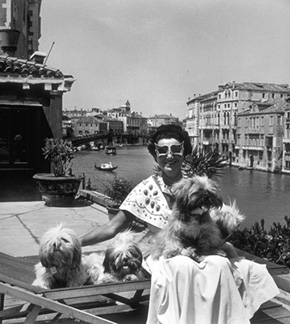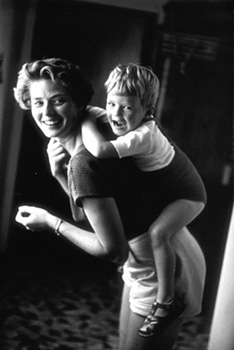
Chim and Marilyn Monroe at The 21 Club. New York City, circa 1952.
Photograph by Burt Glinn.
�1996 Burt Glinn

Sophia Loren at home. Naples, 1955
�1996 from the Estate of David Seymour

Peggy Guggenheim, heiress, art collector, patroness, and philanthropist, on the roof of her Palazzo Balbi, which overlooks the Grand Canal. Venice, 1950
�1996 from the Estate of David Seymour

Bernard Berenson, renowned art critic and author, at the age of 90 in the Borghese Gallery. Rome, 1955
�1996 from the Estate of David Seymour

Ingrid Bergman at home with her son, Robertino Rossellini. Santa Marinella, Italy, 1956
�1996 from the Estate of David Seymour
|
In those years, Magnum photographers helped each other, not only
with their work, but sometimes also emotionally. Just before
Magnum was founded, Robert Capa had ended a love affair with
Ingrid Bergman. She was then still married to her first husband, the
Swedish surgeon Peter Lindstrom, and she was an idol of public and
press. Bob felt marrying would not be compatible with his work as a
photographer, but they remained friends. In 1950 Ingrid gave birth to
her first child with Roberto Rossellini. The world press hounded her
for pictures, at the same time reviling her for having left her first
husband and daughter. Chim was the only one Ingrid allowed to
photograph her. Ingrid became, as Chim used to say, his "favorite
subject." Two years later, Chim went down once again to Santa
Marinella, and took the now- classic photographs of Ingrid and the
twins. Ingrid soon wrote to him:
Dear Chim:
You are a marvelous photographer and I am a marvelous baby maker!
Of course I have 103 requests among friends for these photos. You
would do me a great favor if you burned number 85 even a
marvelous photographer can go wrong! I am glad you realize that I
am not the bathing suite type, either.
By 1953, Chim was in charge of the very complicated Magnum
finances. George Rodger said, "Chim was brilliant in Magnum
meetings, capable of making even the most cockeyed scheme not only
feasible but financially stable." In the meetings, he was the mediator
and peacemaker when tempers flared, usually on the subject of
stories to be photographed, and how they might be financed.
In 1953, Chim in Rome, wrote to Magnum, New York:
Four days later Bob stepped on a mine and was killed. He was
forty years old. Chim had not yet heard that Werner Bischof had
fatally plunged into a gorge in the Andes on May 16. He was thirty-
eight years old; his second son, Daniel, had been born the day Bob
Capa died.
Everyone at Magnum was stunned. Chim flew to Paris and
consulted with Cartier-Bresson. He wrote to all photographers and
staff:
May 27, 1954
My dear Magnum family:
The lump is still in the throat, the dust not settled yet. The blow
is hard, and the reaction slow to come. Somewhere, however, there is
a faint reasonableness coming, and the realization that the reality
has to be faced.
If we are all numb at present, it looks like that soon enough we
will have to face it. So we have to go on, keep together, and avoid
the stunning effects of our sorrow. Maybe through this we will help
ourselves, and find strength to keep and develop Magnum as a home for
all of us.
Soon thereafter, Chim went to New York for the funeral and to
take Magnum affairs in hand.
Julia Friedman, Bob Capa's mother was distraught. Like a son,
Chim stood next to Julia with Bob's younger brother, Cornell, willing
her not to jump into the open grave.
Martha Gellhorn, who first knew Bob Capa and Chim during the
Spanish civil war, draws a fine picture of Chim and his relationship
with Capa in her short story, "Until Death Us Do Part," written in 1958.
In the story, Gellhorn has changed Chim's name to Lep, and Capa's to
Bara. The narrator is a woman who wants Bara for herself:
Bara and Lep worked as partners, covering the war for several
magazines and papers in England and America; they divided the
stories but Bara did not like Lep to go to the worst places; he had
some anxious feeling about Lep's eyes and his huge horn-rimmed
spectacles. If he protected anyone in the world, it was Lep. She was
jealous of Lep...Should she parade her jealousy and force choices,
Bara would take Lep.... Bara loved Lep; he needed Lep as he needed
no one else; Lep was the one fixed point in his life.... Bara was so
dashing in his special Gypsy way, loved by women, welcomed by men,
a life giver.... And Lep looked something like an owl and something
like a panda and something like a head of Buddha, quiet to the verge
of invisibility, a man who smiled slowly and rarely laughed, a serious
man, given to serious obscure friends like archaeologists and doctors
and musicians in Philharmonic orchestras, a small gentle man with a
domed forehead over his vast spectacles, not at all a man for war, a
professor, who astonishingly enough was only two years older than
Bara and often seemed old enough to be Bara's father.
Bara said that Lep was the finest photographer alive, an artist,
not a hit-and-run man with a camera like himself. Bara's pictures
were the famous ones; everyone wanted Bara's work if they could
get it; yet Bara only valued his pictures if Lep did; Lep was his final
judge. His final judge in everything, she thought, for if Bara made the
decisions in his final way, Lep had the right of veto, which he exerted
quietly, hardly bothering to explain himself.... If Lep did not want to
do something, then it should not be done; if Lep did not like
something, then it was not to be liked.
He was now president, and unlike any other Magnum president,
before or since, Chim's photography did not suffer during his
presidential term. His output of administrative work and story
coverage was prodigious.
Chim had thought of everything for Magnum, spending months
working out issue of money and control. Having written the bylaws of
the group he then asked all the photographers (after Capa's death) to
make a will. But his own tragic fate could not be foreseen, and he
forgot to write one for himself.
Beat The Devil, directed by John Huston, was one of the movies
Magnum publicized. Chim had met Gina Lollobrigida on the movie set
in Amalfi. She was very new in the industry, and so far mainly a
cheesecake attraction. Chim was taken with Gina, not only with her
splendid physique, but also because she had been an art student,
designed all her own clothes, and was determined to succeed as a
serious actress. Moreover she was puritanically modest, and so the
gentlemanly Chim was just the person to entrust with the story of
her transformation. Chim did several stories on her, and all were
widely published; one week both Life and Look featured covers of
Gina photographed by Chim. Word got around, and soon he was asked
to publicize other new stars, Kim Novak, Joan Collins, even Ava
Gardner and Audrey Hepburn. True magazine, not a regular Magnum
client, asked Chim to photograph Sophia Loren. They were not satisfied,
and asked for more material. Chim responded, "The news that she
was not exciting enough was the greatest blow to my masculinity.... I
must be oversexed."
Entertainment and tourism were strong subjects in the fifties,
and coverage of movies for magazine publication became a lucrative
and interesting proposition for Magnum photographers; they
corresponded with Chim's way of doing stories that would elevate the
spirit. But there were other topics that Chim felt would benefit the
public: one of them was his coverage of the fiftieth Nobel prize
ceremony. Another humanistic report was a mini-series that he
proposed to his regular client Newsweek that would "dramatize the
human qualities of modern missionaries (teachers, technicians,
scientists, officials, experts, etc.). The conception of good-doers is
lately ill considered. I feel it would be important to glamorize them,"
he wrote. Eventually, this series transformed into one on old men
who had, in their lives' work, elevated the spirit of mankind. It
cannot be coincidence that Chim chose as his first subject a man for
whom music was the essence of life. Chim, who had first thought of
becoming a pianist, made haunting pictures of Toscanini at the
keyboard. These are only excelled by his reportage on the ninety-
year-old Bernard Berenson, especially one photograph of the old man
yearning over the cold marble of a reclining nude. Like Berenson,
Chim was addicted to looking, a connoisseur of the gentle sex, not
only in art, but also in the flesh. They both loved beauty.
- Inge Bondi
� 1996, Inge Bondi
from CHIM: The Photographs of David Seymour, Bulfinch Press/Little, Brown and Company
|





































